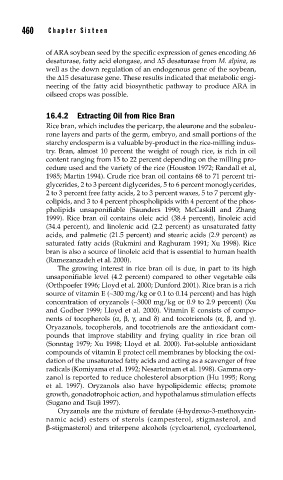Page 488 - Biosystems Engineering
P. 488
460 Cha pte r S i x tee n
of ARA soybean seed by the specific expression of genes encoding Δ6
desaturase, fatty acid elongase, and Δ5 desaturase from M. alpina, as
well as the down regulation of an endogenous gene of the soybean,
the Δ15 desaturase gene. These results indicated that metabolic engi-
neering of the fatty acid biosynthetic pathway to produce ARA in
oilseed crops was possible.
16.4.2 Extracting Oil from Rice Bran
Rice bran, which includes the pericarp, the aleurone and the subaleu-
rone layers and parts of the germ, embryo, and small portions of the
starchy endosperm is a valuable by-product in the rice-milling indus-
try. Bran, almost 10 percent the weight of rough rice, is rich in oil
content ranging from 15 to 22 percent depending on the milling pro-
cedure used and the variety of the rice (Houston 1972; Randall et al,
1985; Martin 1994). Crude rice bran oil contains 68 to 71 percent tri-
glycerides, 2 to 3 percent diglycerides, 5 to 6 percent monoglycerides,
2 to 3 percent free fatty acids, 2 to 3 percent waxes, 5 to 7 percent gly-
colipids, and 3 to 4 percent phospholipids with 4 percent of the phos-
pholipids unsaponifiable (Saunders 1990; McCaskill and Zhang
1999). Rice bran oil contains oleic acid (38.4 percent), linoleic acid
(34.4 percent), and linolenic acid (2.2 percent) as unsaturated fatty
acids, and palmetic (21.5 percent) and stearic acids (2.9 percent) as
saturated fatty acids (Rukmini and Raghuram 1991; Xu 1998). Rice
bran is also a source of linoleic acid that is essential to human health
(Ramezanzadeh et al. 2000).
The growing interest in rice bran oil is due, in part to its high
unsaponifiable level (4.2 percent) compared to other vegetable oils
(Orthpoefer 1996; Lloyd et al. 2000; Dunford 2001). Rice bran is a rich
source of vitamin E (∼300 mg/kg or 0.1 to 0.14 percent) and has high
concentration of oryzanols (∼3000 mg/kg or 0.9 to 2.9 percent) (Xu
and Godber 1999; Lloyd et al. 2000). Vitamin E consists of compo-
nents of tocopherols (α, β, γ, and δ) and tocotrienols (α, β, and γ).
Oryazanols, tocopherols, and tocotrienols are the antioxidant com-
pounds that improve stability and frying quality in rice bran oil
(Sonntag 1979; Xu 1998; Lloyd et al. 2000). Fat-soluble antioxidant
compounds of vitamin E protect cell membranes by blocking the oxi-
dation of the unsaturated fatty acids and acting as a scavenger of free
radicals (Komiyama et al. 1992; Nesartetnam et al. 1998). Gamma ory-
zanol is reported to reduce cholesterol absorption (Hu 1995; Rong
et al. 1997). Oryzanols also have hypolipidemic effects; promote
growth, gonadotrophoic action, and hypothalamus stimulation effects
(Sugano and Tsuji 1997).
Oryzanols are the mixture of ferulate (4-hydroxo-3-methoxycin-
namic acid) esters of sterols (campesterol, stigmasterol, and
β-stigmasterol) and triterpene alcohols (cycloartenol, cyccloartenol,

